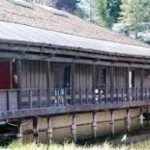My Musical Career | Part Nine
In my previous blogposts, I wrote quite a bit about Fred D. Hinger, my main percussion instructor and mentor and some of the experiences I had with him at the school. I had four good years working under his tutelage – including a summer at Aspen, Colorado. This was in the summer of 1973, and together with Charlie Owen, his former colleague from Philadelphia Orchestra days and at the time percussion instructor at the University of Michigan – they headed up the percussion faculty at the Aspen Music School, which was part of the Aspen Music Festival. I had by this time finished my junior year at MSM, and was about to embark on my senior year. Mr. Hinger mentioned to me during one of my lessons the possibility of coming out to Aspen for the summer to broaden my musical experiences. At the time, Aspen offered two options: the full nine-week course, which began at the end of June, or a shortened four week course, which began at the beginning of August. My parents and I discussed this thoroughly and they agreed that it would be a good thing for me to do, but that finances would dictate that I take the four-week course. So it was decided that I would enroll in the four-week course. In order to reduce expenses further, it was decided that I would fly out to the Festival, but would return with two of my fellow students at the Festival and MSM, Gary Whiton and Carl Rendek, who would be driving back. So, at the end of July, 1973, I finished my summer job with Con Edison one month early, and packed my things and headed for the airport.
Aspen 1973
Aspen, Colorado was then, and is still a beautiful place, but it is a trendy, tony place. The Music Festival and School had two different locations. Performances were done at the Festival’s Music Tent, which was quite elaborate and secure, much more than the moniker “Music Tent” implies. This tent was quite secure and had excellent backstage facilities as well as a solid stage and electrical facilities. Seating was quite comfortable and it was managed quite properly.
It was located just outside of the downtown area. The Aspen Music School, on the other hand, was located about three miles outside of town, in a beautiful park-like setting.The students were housed in Aspen itself – in two different hotels. I shared a room with Gary Whiton at the Continental Inn. Transportation to the Music School and back was by school bus, and Carl Rendek, a fellow MSM student – managed to get himself hired as a part-time bus driver while taking lessons and performing. This was a boon to Gary and I, because we always knew when the buses were running or if there was going to be an extra bus and could plan accordingly.
Rehearsals and lessons always took place at the Music School, and there was a building devoted to percussion studios with a large rehearsal space for percussion ensemble. I flew out of New York on a United Airlines DC-8 (incidentally, this was the first time I had ever flown) and landed at Denver’s Stapleton Airport. I switched to a DC-3 operated by Rocky Mountain Airlines. The DC-3 was old, but had been refurbished and it was an uneventful flight, but I had been put next to one of the engines, and the plane being a prop job, the noise was deafening to say the least. However, I was able to endure the noise and enjoy the great scenery outside the window, and before I knew it, we had landed at the Aspen airport. I was met by another fellow student from MSM, Andy Feldman – who had borrowed Mr. Hinger’s famous white Volkswagen in order to pick me up. It turned out that Andy drove the VW out to Aspen for Mr. Hinger while the Hingers flew out to Aspen. Andy told me that it was a rather eventful trip out, but he and the car made it out in good shape.
The others had the advantage of being out at the festival for five weeks and had long since become acclimated to the environment. I, on the other hand, had to jump right in and get on with the schedule, and it was a pretty demanding one. Mr. Hinger threw me a bit of a curve by suggesting that I take this summer to study with Charles Owen, his colleague from the Philadelphia Orchestra days, and in retrospect, I probably should have taken his advice, as Charlie (as he was called, although not be us) was an excellent teacher and greatly respected. However, being the stubborn sort, I always walk to the beat of my own drummer and elected to stay with Mr. Hinger. I probably missed out on some excellent tips that would have benefited me as a percussionist. However, Mr. Hinger didn’t put up too much of a case for me studying with Charlie, so I remained in his studio, for which I am glad that I did. I received a lot of good advice and tips with regard to performance, and was able to observe him in actual orchestral performance with the Aspen Festival Orchestra for three concert cycles. He did not do the last cycle as he left one week early for New York due to rehearsal committments with the Metropolitan Opera Orchestra. I was assigned to play timpani for a concert with the Symphonic Winds, conducted by Keith Brion; a winds/brass percussion class conducted by the festival’s music director Jorge Mester and Otto-Werner Mueller, and I played percussion with the Aspen Chamber Smphony in a concert under the direction of Herbert Blomstedt. The program included a work in which I played percussion, which was Paul Hindemith’s Nobilissima Visione – and I remember being a little intimidated by Mr. Blomstedt as he was so serious. He was very polite, but very businesslike and he got a great performance from the orchestra. Mr. Hinger liked him and said that his performance of Bruckner’s Fourth earlier that summer was superb. It seemed like everything that was “superb” was earlier that summer. Playing with the Aspen Wind Symphony was a lot of fun. The main work was the Suite from “The Good Soldier, Shweik” by Robert Kurka, which has a soloistic part for the timpani and percussion. Rehearsals and performance went well, and I was complimented on my performance by both Mr. Hinger and Mr. Owen.
Later that day, all of us who played that performance were reprimanded for leaving the percussion instruments in less-than-pristine condition (which meant that the covers were not put on the instruments after the performance as they should have been). I guess we were so relieved to have pulled off a good performance that we forgot to take care of business, and Mr. Hinger was doing his duty, as he should have in making sure that this never happened again. Being the gentleman that he was, after giving us the lecture on post-performance protocol, he again complimented us on our performance.
Percussion Ensemble with Charlie Owen
One of the classes that we percussionists were assigned to was Percussion Ensemble, which was conducted by Charlie Owen. He was just great. He was cheerful, organized, and laid back in a way that enabled him to get things done and create an atmosphere of learning in which musicianship, technique and fun were blended in to create a very good result. Two of the main works on the season’s Percussion Ensemble Concert were Michael Udow’s “African Welcome” and Robert Kelly’s “Concerto for Marimba and Percussion Ensemble”. I remember vividly how Mr. Owen deployed the ensemble for the Udow piece, which in addition to the normal percussion instruments, required several players with plastic tubes to sit before the ensemble and whirl these tubes over their heads – creating a high-pitched rippling sound – as part of the score. It turned out to be a lot of fun. The Kelly Marimba Concerto turned out to be a bit of a challenge for me – one of the instruments assigned to me was tambourine, and the part was full of thumb-rolls – and I having a dry thumb –could not do a very secure thumb roll. Mr. Owen was extremely patient with me and spent quite a bit of time teaching me how to do a thumb roll – so you see, I did get something from Mr.Owen after all! After a lot of practice, and a lot of wetting my thumb, I managed the part satisfactorily.
Mr. Hinger and the Festival Orchestra
I had seen Mr. Hinger perform with the Aspen Festival Orchestra for three concerts, all under the direction of Jorge Mester. The programs included Elliot Carter’s Variations for Orchestra; Beethoven’s “Pastoral” Symphony; Schumann’s “Spring”Symphony”; Saint-Saen’s “Organ” Symphony, among others. He really “nailed “each one, and was at the height of his powers. Up until this time, I had the opportunity of watching him perform at the Metropolitan Opera, either from a seat in the hall (or listening from a score-desk at the very top of the huge theater), or seated next to him in the pit (more on that in a later post). This was the first (and sad to say) only time that I saw him performing in a symphony orchestra environment, and incidentally, on plastic heads. This was necessitated by the fact that all performances were in the Aspen Music Festival Tent, which while equipped with excellent backstage and stage facilities, was still considered “outdoors.” Mr. Hinger disliked playing on plastic and avoided it if he could, but was also an extremely practical musician and used it when necessary. Nonetheless, it was strange to hear him on plastic, although his sound and technique was excellent and fully up to his standard. The one piece besides the Saint-Saens in which Mr. Hinger and Charlie Owen played side-by-side was Dvorak’s “Sscherzo Capricciso” – with Dan Hinger on timpani and Charlie Owen on cymbals, it reminded me of the old “Philadelphia” sound, and I know each enjoyed working with the other again, even if it was only for a summer.
As Mr. Hinger had to leave the Festival a week early, I had the opportunity to see Charlie Owen sit in for him on Mahler’s Fifth Symphony. It would have been great to see Mr. Hinger play this magnificent part, but Charlie did it justice and played extremely well, even though his technique was more traditional in style. Both of these gentleman were great musicians and it was truly an honor to work with both of them.



Recent Comments